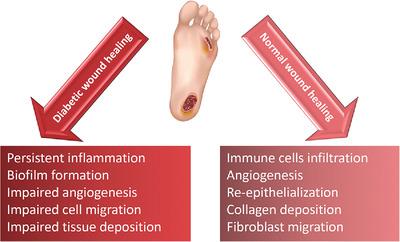当前位置:
X-MOL 学术
›
Biotechnol. Appl. Bioc.
›
论文详情
Our official English website, www.x-mol.net, welcomes your feedback! (Note: you will need to create a separate account there.)
Nanotechnology-driven advances in the treatment of diabetic wounds
Biotechnology and Applied Biochemistry ( IF 2.8 ) Pub Date : 2020-10-12 , DOI: 10.1002/bab.2051 Hosna Zare 1, 2, 3 , Majid Rezayi 4, 5 , Ehsan Aryan 1, 2 , Zahra Meshkat 1, 2 , Behnaz Hatamluyi 6 , Alireza Neshani 7 , Kiarash Ghazvini 1, 2 , Mohammad Derakhshan 1, 2 , Mojtaba Sankian 8
Biotechnology and Applied Biochemistry ( IF 2.8 ) Pub Date : 2020-10-12 , DOI: 10.1002/bab.2051 Hosna Zare 1, 2, 3 , Majid Rezayi 4, 5 , Ehsan Aryan 1, 2 , Zahra Meshkat 1, 2 , Behnaz Hatamluyi 6 , Alireza Neshani 7 , Kiarash Ghazvini 1, 2 , Mohammad Derakhshan 1, 2 , Mojtaba Sankian 8
Affiliation

|
Diabetic foot ulcers (DFUs) are chronic severe complications of diabetes disease and remain a worldwide clinical challenge with social and economic consequences. Diabetic wounds can cause infection, amputation of lower extremities, and even death. Several factors including impaired angiogenesis, vascular insufficiency, and bacterial infections result in a delayed process of wound healing in diabetic patients. Treatment of wound infections using traditional antibiotics has become a critical status. Thus, finding new therapeutic strategies to manage diabetic wounds is urgently needed. Nanotechnology has emerged as an efficient approach for this purpose. This review aimed to summarize recent advances using nanotechnology for the treatment of diabetic wounds.
中文翻译:

纳米技术推动糖尿病伤口治疗的进步
糖尿病足溃疡 (DFU) 是糖尿病的慢性严重并发症,并且仍然是具有社会和经济后果的全球性临床挑战。糖尿病伤口会导致感染、下肢截肢,甚至死亡。包括血管生成受损、血管功能不全和细菌感染在内的几个因素导致糖尿病患者的伤口愈合过程延迟。使用传统抗生素治疗伤口感染已成为一种关键状态。因此,迫切需要寻找新的治疗策略来处理糖尿病伤口。为此目的,纳米技术已成为一种有效的方法。本综述旨在总结使用纳米技术治疗糖尿病伤口的最新进展。
更新日期:2020-10-12
中文翻译:

纳米技术推动糖尿病伤口治疗的进步
糖尿病足溃疡 (DFU) 是糖尿病的慢性严重并发症,并且仍然是具有社会和经济后果的全球性临床挑战。糖尿病伤口会导致感染、下肢截肢,甚至死亡。包括血管生成受损、血管功能不全和细菌感染在内的几个因素导致糖尿病患者的伤口愈合过程延迟。使用传统抗生素治疗伤口感染已成为一种关键状态。因此,迫切需要寻找新的治疗策略来处理糖尿病伤口。为此目的,纳米技术已成为一种有效的方法。本综述旨在总结使用纳米技术治疗糖尿病伤口的最新进展。



























 京公网安备 11010802027423号
京公网安备 11010802027423号